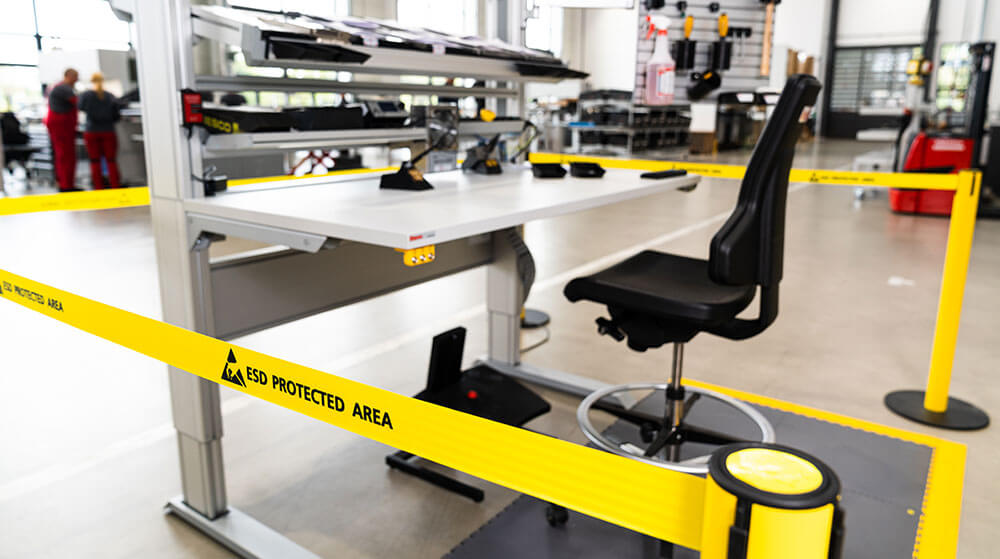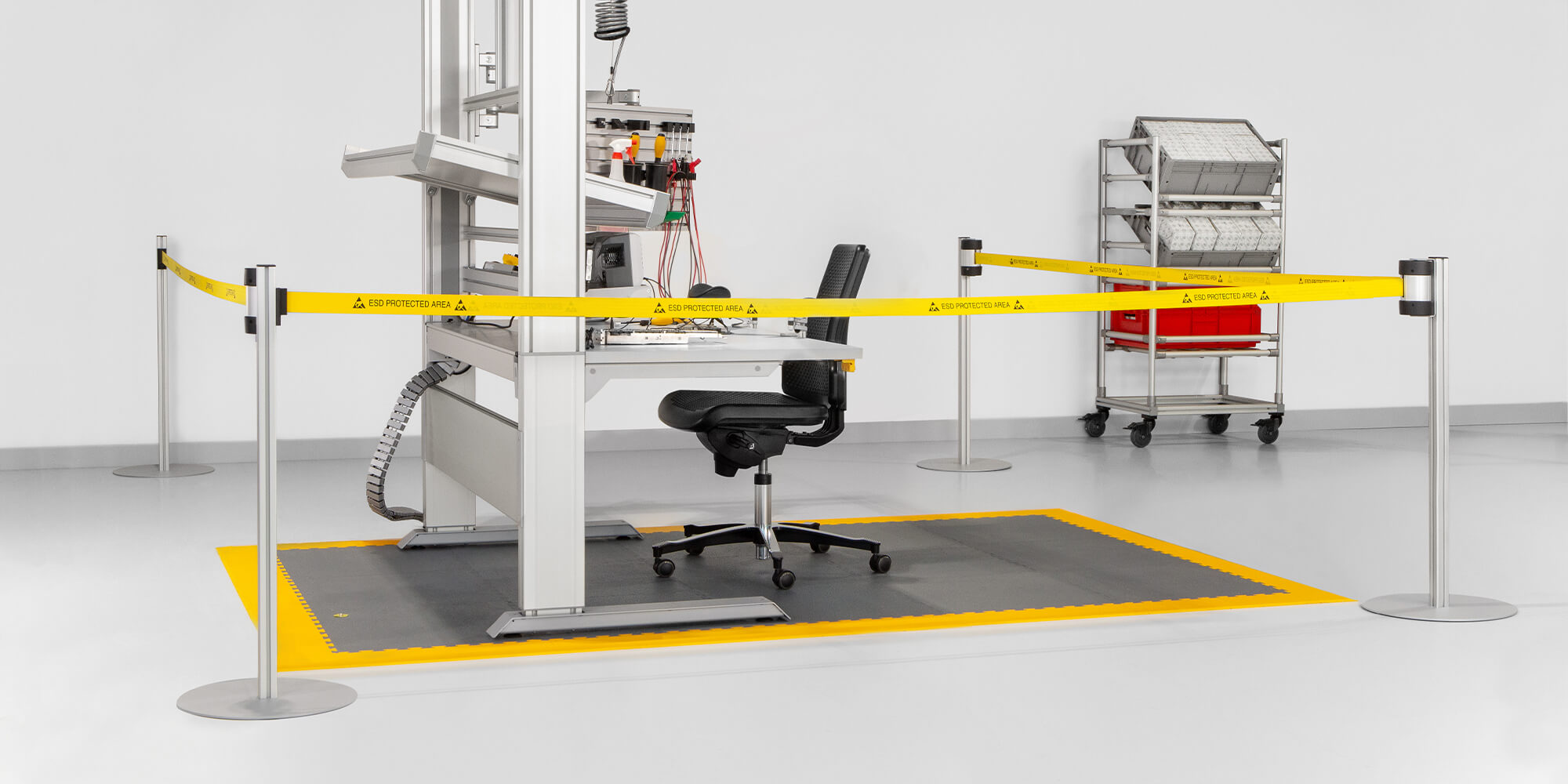ESD damage can have expensive consequences for manufacturing companies. Find out the best ways to avoid this danger using ESD protection zones.
ESD is often considered an “invisible danger”. What exactly does that mean? Imagine the following example – a company packages an electronic component. The customer installs it in a control unit. Eight months later, the component fails at a critical point in the production process, causing a system outage that lasts eight hours. Naturally, the customer is very unhappy about this, and demands a replacement. As a result, the company suffers financial losses, as well as losing the trust of its customer. What happened? There was an electrostatic discharge (ESD) during the packaging process. This is an everyday physical occurrence – an uncontrolled equalisation of electrical charges between two objects that are charged differently.
Employees noticed nothing during packaging. The threshold for human perception of ESD is around 3000 volts (V). You will be familiar with the painful shock you sometimes get from a door handle. Even small discharges of 30 V can damage electronic components. In most cases, unrecognisable preliminary damage occurs, which leads to an unforeseeable defect or failure of the component in the course of the operating time. ESD protection is designed to prevent this kind of effects. The electrostatic protected area (EPA) is at the heart of this specialist discipline. Setting up an EPA will enable you to avoid damage caused by electrostatic discharge in a targeted way. We are happy to help you do this using our ESD-safe products and our wide-ranging expertise.

Guide: The 10 golden rules of ESD safety
Specialist expertise in all aspects relating to effective protection against ESD at the workstation, presented in a compact format that includes a practical checklist for continuously enhancing ESD safety in your company.
Get the white paper now
What is an ESD protection zone? Plus: Access and ideal conduct
EPAs can be anything from a single workstation or a defined space to an entire building. They are clearly delineated protected areas. Components that are sensitive to electrostatic discharge (= ESDS) must only be handled in an EPA. There are strict access restrictions. Only trained staff wearing ESD protective clothing correctly may enter. The equipment includes an ESD lab coat, special ESD shoes, and often also an ESD wristband. There are numerous factors that can reduce the effectiveness of the ESD protection offered by the equipment, including damage, soiling, wear, and inappropriate use. Check the protective equipment and charge of the staff at least once a day before they enter the EPA. Access control systems using barriers or turnstiles link this check with EPA access, preventing unauthorised or inadequately equipped individuals from gaining entry.
Components are generally protected by packaging and transport containers. They are only to be handled directly within an EPA.
Unprotected areas (UPAs) are the opposite of ESD protection zones. The stringent requirements of a protection zone do not apply to UPAs. It is particularly important to differentiate and delineate between the two kinds of area. With larger EPAs, this can be done using appropriate marking strips or coloured flooring. Barriers with retractable belts offer a useful addition. Together with warning notices, the gaps in these delineations form the entry and exit points of the electrostatic protected area. ESD-sensitive components must never be brought into or removed from the area without protection. These components are generally protected by packaging and transport containers. They are only to be handled directly within an EPA. Ideal conduct in the ESD protection zone is based primarily on two aspects – correct use of safety equipment and knowledge of rules of behaviour.

Protecting products from electrostatic discharge
Find out more about ESD in the interactive item Academy. The online training course explains the causes and key protection measures in detail.
EXPAND YOUR TRAINING NOW
The role of flooring in the ESD protection zone
Fundamentally, the floor of an EPA must be electrostatically dissipative. In addition, it is connected to the earth at enough points to ensure adequate discharge resistance on every part of the floor. Interlocking mats are often sufficient for smaller zones. These form an additional floor covering. Use electrostatically dissipative flooring for the whole area of larger zones. Only use specialist cleaning agents that maintain the dissipative characteristics of the surface to clean ESD flooring. This is the only way to ensure the electrostatic charge of the human body is dissipated immediately through the floor. The ESD shoes employees wear have the volume resistance required and establish contact with the floor.
Ideal work bench for ESD protection
Whether as part of a larger EPA or as a smaller EPA consisting of only one bench, an ESD work bench with a volume-conductive table top is a must. Configure your ESD bench with our free Work Bench Configurator. One particular highlight is that this configurator defines and visualises the EPA in each case. ESD table mats are only an option where components are being handled in a small area. In addition, staff wear an ESD wristband. In general, all ESD protective elements should be systematically earthed via the table frame. There are various options for this connection – a separate earthing line, the protective earth of the power supply or a potential equalisation system. The tasks being carried out there determine the other protective measures needed on the ESD bench. If you need tools, these can only be special ESD tools, which require suitable tool holders with ESD protection. At a distance of less than 30 centimetres from a sensitive component, tools, tool holders and parts containers must be electrostatically dissipative. You should also take care to ensure high quality when choosing movable components. Friction can quickly cause a charge to build up. The joints of tool holders should not be isolating, which is why the pivot arms in our modular item Work Bench System always feature metal contacts.
When our ESD work benches are delivered, you receive a special ESD record that proves your ESD work bench has been checked at all ESD measuring points.
When it comes to the safety of ESD benches, the internationally recognised standard IEC 61340 is decisive. This standard sets out the limits for discharge resistance and surface resistance. All work and storage surfaces are particularly important. In addition to satisfying the stipulated maximum resistance, these must also meet a minimum requirement. This ensures potential charges don’t dissipate too quickly and cause damage. For every ESD bench, insist on a customised check of ESD safety by the manufacturer. This aspect is often overlooked. When our ESD work benches are delivered, you receive a special ESD record.
- Certification: Your ESD work bench has been checked at all ESD measuring points
- Standard points: ESD table top and storage surfaces
- Additional points: Customised, defined in consultation with you
This ensures the solution delivered is properly designed with the correct discharge resistance. At the actual place of use, the IEC 61340 inspection programme requires an initial and subsequent regular inspection to be carried out or arranged by the operator. Invisible to the eye, but dangerous – cleaning the work bench incorrectly or not at all compromises the electrostatic dissipation.

Work chairs and other factory equipment for use in EPAs
The quality of work chairs plays a significant role in the health of employees. In EPAs, work chairs are close to processes and safety relevant. Select chairs that are both ergonomic and ESD safe. Our ESD-safe work chairs meet both these criteria. As a result, employees can adjust the chair to their own needs while still meeting EPA requirements. An electrostatically dissipative foot rest is particularly useful for easing the strain on smaller employees.
The safe integration of the ESD protection zone into the intralogistics is a particular challenge, as movement and friction are inevitable. Transport crates and the roller elements and side guides on roller conveyors have a particularly high potential for electrostatic charging. Transport trolleys and conveyor belts also pose an enormous risk. We know the challenges of intralogistics and can offer you targeted support. You can rely on our ESD-safe roller conveyors, transport trolleys and conveyor belts. One particularly practical feature: In the free item Engineeringtool, you can design whole conveyor sections online.
We know the challenges of intralogistics and can offer you targeted support. You can rely on our ESD-safe roller conveyors, side guides, transport trolleys and conveyor belts.
Regular measurements are particularly important for transport trolleys, as dirt deposits can negatively impact the electrostatic dissipation of ESD roller elements in the medium term. Operational influences and dynamics put a great deal of strain on the roller elements. Perform regular measurements on these. In addition, fit your transport trolleys with ESD drag chains. The stainless steel ESD Drag Chain dissipates electrostatic charges by maintaining permanent contact with the ESD-safe floor. As you can see, there are many aspects involved in creating an EPA, and these also include climate control and ionisation. You can find all the details in our free white paper about ESD protection zones.
Whether in intralogistics or when equipping a workstation, our modular system can utilise its advantages exactly according to your individual requirements. The invisible danger doesn’t become visible (and it would be too late, anyway). Instead, something even better is achieved – eliminating the risk of ESD as far as possible.
Thanks to our online tools, you can see what your complete solution will look like while you are designing it: Detailed in 3D and with full documentation.
Interested in applications and solutions for ESD safety? Then we have something that’s right up your street! Simply subscribe to the item blog by completing the box at the top right.





